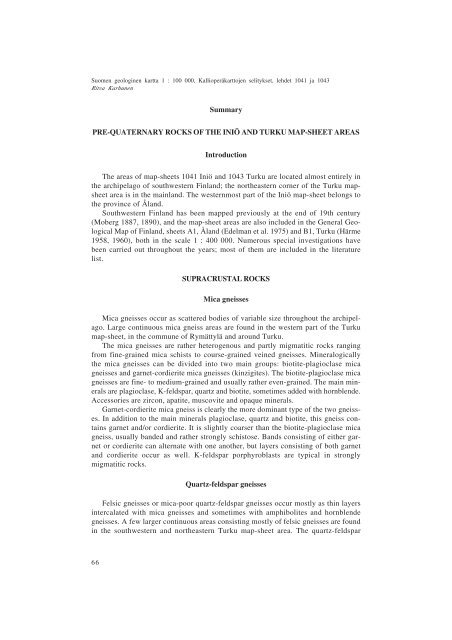Ritva Karhunen - arkisto.gsf.fi - Geologian tutkimuskeskus
Ritva Karhunen - arkisto.gsf.fi - Geologian tutkimuskeskus
Ritva Karhunen - arkisto.gsf.fi - Geologian tutkimuskeskus
You also want an ePaper? Increase the reach of your titles
YUMPU automatically turns print PDFs into web optimized ePapers that Google loves.
Suomen geologinen kartta 1 : 100 000, Kallioperäkarttojen selitykset, lehdet 1041 ja 1043<br />
<strong>Ritva</strong> <strong>Karhunen</strong><br />
66<br />
Summary<br />
PRE-QUATERNARY ROCKS OF THE INIÖ AND TURKU MAP-SHEET AREAS<br />
Introduction<br />
The areas of map-sheets 1041 Iniö and 1043 Turku are located almost entirely in<br />
the archipelago of southwestern Finland; the northeastern corner of the Turku mapsheet<br />
area is in the mainland. The westernmost part of the Iniö map-sheet belongs to<br />
the province of Åland.<br />
Southwestern Finland has been mapped previously at the end of 19th century<br />
(Moberg 1887, 1890), and the map-sheet areas are also included in the General Geological<br />
Map of Finland, sheets A1, Åland (Edelman et al. 1975) and B1, Turku (Härme<br />
1958, 1960), both in the scale 1 : 400 000. Numerous special investigations have<br />
been carried out throughout the years; most of them are included in the literature<br />
list.<br />
SUPRACRUSTAL ROCKS<br />
Mica gneisses<br />
Mica gneisses occur as scattered bodies of variable size throughout the archipelago.<br />
Large continuous mica gneiss areas are found in the western part of the Turku<br />
map-sheet, in the commune of Rymättylä and around Turku.<br />
The mica gneisses are rather heterogenous and partly migmatitic rocks ranging<br />
from <strong>fi</strong>ne-grained mica schists to course-grained veined gneisses. Mineralogically<br />
the mica gneisses can be divided into two main groups: biotite-plagioclase mica<br />
gneisses and garnet-cordierite mica gneisses (kinzigites). The biotite-plagioclase mica<br />
gneisses are <strong>fi</strong>ne- to medium-grained and usually rather even-grained. The main minerals<br />
are plagioclase, K-feldspar, quartz and biotite, sometimes added with hornblende.<br />
Accessories are zircon, apatite, muscovite and opaque minerals.<br />
Garnet-cordierite mica gneiss is clearly the more dominant type of the two gneisses.<br />
In addition to the main minerals plagioclase, quartz and biotite, this gneiss contains<br />
garnet and/or cordierite. It is slightly coarser than the biotite-plagioclase mica<br />
gneiss, usually banded and rather strongly schistose. Bands consisting of either garnet<br />
or cordierite can alternate with one another, but layers consisting of both garnet<br />
and cordierite occur as well. K-feldspar porphyroblasts are typical in strongly<br />
migmatitic rocks.<br />
Quartz-feldspar gneisses<br />
Felsic gneisses or mica-poor quartz-feldspar gneisses occur mostly as thin layers<br />
intercalated with mica gneisses and sometimes with amphibolites and hornblende<br />
gneisses. A few larger continuous areas consisting mostly of felsic gneisses are found<br />
in the southwestern and northeastern Turku map-sheet area. The quartz-feldspar

















